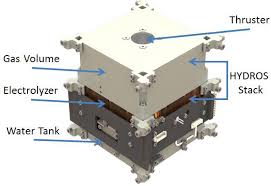My last blog talked about space tethers. One of the pioneer companies researching space tethers is Tethers Unlimited. They have been around for over twenty years and for many of those years they subsisted on occasional grants. In the past few years, their focus has shifted away from space tethers and onto other space technologies that are more in demand. One of the products they are now selling is the Hydros Water Electrolysis Thruster or Hydros Propulsion System.
Satellite launches are very expensive. Millions of dollars are involved in sending a big satellite into orbit. There is often some room left in the payload of a major launch and this space is sold to other companies for the launch of small satellites such as CubeSats. CubeSats were developed in 1999 by California Polytechnic State University (Cal Poly) and Stanford University to promote the design, manufacture and testing of small satellites intended for low Earth orbit. The size of CubeSats is measured in ten by ten by eleven and one third centimeters volumes which are referred to as "units". They cannot be over one and one third kilograms per unit.
Hitching a ride on a big satellite launch makes it much cheaper to get CubeSats into orbit. However, the CubeSats are just dumped into space when the big satellite reaches its orbit. This leaves the CubeSats in the wrong orbit. In order to reach the correct orbit, the CubeSats have to have some sort of propulsion system to provide thrust.
There are many options for propulsion for these CubeSats. Pressurized tanks of cold gas such as nitrogen can be used but they have very low performance. Chemical thrusters require propellant which is not allowed when launched with a big satellite. Various electrical thrusters are being researched including Hall-effect thrusters, ion thrusters, pulsed plasma thrusters, electrospray thrusters, and resistojets. However, these require a lot of power which means big solar cells and/or batteries. Some require pressurize propellant which is not allowed in piggy back launches. Solar sails could be used but they take up a lot of space and require complex system for deployment.
Tethers Unlimited has developed a propulsion system for CubeSats that solves many of the problems with other CubeSat propulsion systems. The satellites are launched with water onboard. Once they are dropped off in space, they can deploy solar cells to charge the batteries. The batteries can then power an electrolysis system that separates the hydrogen from the oxygen in the water. The CubeSat now has fuel that can be used in a bipropellant thruster to generate thrust and alter its orbit. Once a new orbit has been achieved, the fuel can be used for station keeping (orbital stabilization). The Hydros thrusters are efficient and powerful. The Hydros currently comes in two versions. One unit and one half unit.
The Hydros is a pulsed propulsion system than cannot provide a constant thrust. However, the company has been working with putting multiple propulsion modules on the same CubeSat so one module can be generating the gases while the other module is firing.
Hydros thruster:
